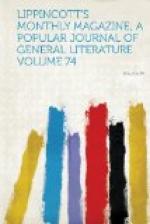* * * * *
The recent proposition of some English writers to elevate a certain class of suicides to the rank of a legalized “institution,” under the pleasant name of “euthanasia,” suggests the inquiry whether, without any scientific vindication of the practice, there will not always be suicides enough in ordinary society. At any rate, however it may be in England, just across the Channel, in France, thousands of people every year break the “canon ’gainst self-slaughter,” leaving the ills they have to “fly to others that they know not of.” The official figures show that in a period of twenty-two years no less than 71,207 persons committed suicide in France. The causes were various—business embarrassments, domestic chagrins, the brutishness produced by liquor, poverty, insanity, the desire to put an end to physical suffering by “euthanasia,” and so on; but they are pretty nearly all included in the “fardels” which Hamlet mentions, from the physical troubles of the “heartache and the thousand natural shocks that flesh is heir to,” up to the mental distress wrought by the “whips and scorns of time, the oppressor’s wrong, the proud man’s contumely, the pangs of despised love,” and so on in the well-remembered catalogue. Perhaps the most interesting point in these statistics concerns the means employed for suicide. These are thus tabulated: Hanging, 24,536; drowning, 23,221; shooting, 10,197; asphyxia by charcoal fumes (a true Paris appliance), 5587; various cutting instruments, 2871; plunging or jumping from an elevated place (an astonishing number), 2841; poison, 1500; sundry other methods, 454. Hanging and drowning are thus accountable for more than half the French suicides. The little stove of charcoal suggests itself as a remedy at hand to many a wretch without the means to buy a pistol or the nerve to use a knife. The cases of voluntary resort to poison are astonishingly few, but it must be remembered that the foregoing figures only embrace successful suicides, and antidotes to poison often come in season where the rope or the river would have made quick and fatal work. La France notes, regarding these statistics, that their details show that men oftenest use pistols, and women oftenest try poison, in their attempts at suicide. What is more curious, each man is likely to employ an instrument familiar to him: thus, hunters and soldiers resort to the pistol, barbers trust the razor, shoemakers use the knife, engravers




